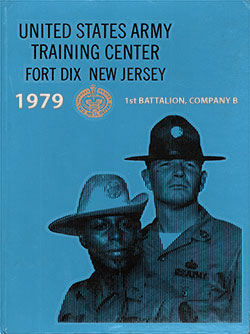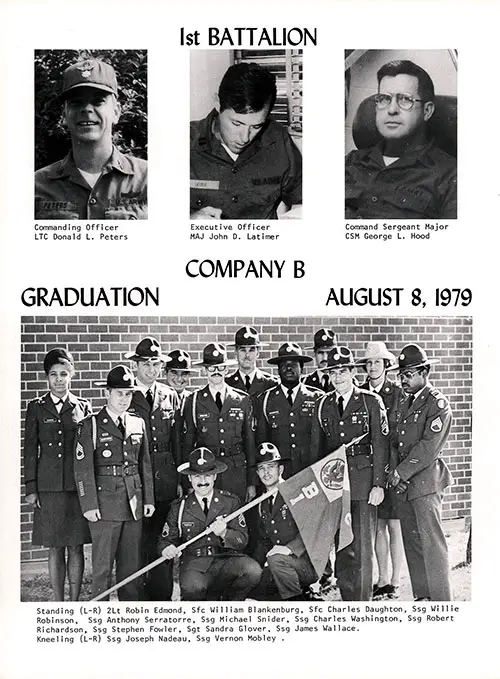Fort Dix 1979 U.S. Army Basic Training Yearbooks – Companies B & C, 1st Battalion, 3rd Training Brigade


📖 Comparative Analysis – Fort Dix 1979 Basic Training Yearbooks
Companies B & C, 1st Battalion, 3rd Training Brigade
Graduation Date: 8 August 1979
Explore the Fort Dix 1979 Basic Training Yearbooks for Companies B & C, 1st Battalion, 3rd Training Brigade. Featuring rosters, portraits, and leadership profiles of nearly 500 recruits, these records highlight the U.S. Army’s diversity and gender integration during the all-volunteer force era.
Yearbooks Being Compared:
⭐ Introduction
The summer of 1979 marked a pivotal moment for the U.S. Army’s all-volunteer force, still less than a decade old. At Fort Dix, New Jersey, two sister companies — Company B and Company C of the 1st Battalion, 3rd Training Brigade — graduated on the same date.
Together, they represent nearly 500 recruits (227 in B, 238 in C), offering a powerful snapshot of the Army’s growing gender integration, ethnic diversity, and leadership development during the Cold War era.
🏅 Shared Themes
📈 Large Training Cohorts
Both Companies graduated well over 200 recruits, reflecting strong enlistment despite lingering Vietnam-era skepticism.
👩✈️ Integration of Women
Both rosters contain significant numbers of women — names like Karen Bacon, Judith Beneventi, Deena Coker, Nancy Revelle (Company B) and Bethany Andrews, Sharon Barnhill, Lori Costello, Kristine Stein, Brenda Turner (Company C) highlight the era’s expanding opportunities for women.
🌍 Diversity in the Ranks
Hispanic, African American, and Asian-American recruits are well represented.
Names such as Nguyen, Phuong (Company B), Mateo, Mayra (Company C), and Wong, John (Company C) illustrate the Army’s role as one of America’s most diverse institutions in the 1970s.
👮 Leadership Consistency
Both Companies were overseen by LTC Donald L. Peters (Commanding Officer), MAJ John D. Latimer (Executive Officer), and CSM George L. Hood (Command Sergeant Major) — ensuring standardized discipline and training across the battalion.
🎖️ Key Differences
| Feature | Company B | Company C |
|---|---|---|
| Company Commander | 2LT Robin Edmond (junior officer, notable responsibility) | 1LT Robert Connor (slightly more experienced) |
| Platoon Leadership | Mixed cadre of SFCs, SSGs, and one female Platoon Sergeant (Sgt Sandra Glover) | Similar cadre, but included Sgt Inez M. Paroly, another female leader |
| Roster Size | 227 recruits | 238 recruits |
| Roster Diversity | Strong female representation, plus international names like Nguyen, Phuong (Vietnamese heritage) | Greater Latino presence: Iris Perez, Juan Videa, Luis Guerrero, Mayra Mateo |
| Image Notes | Leadership photo emphasizes male-heavy cadre with Sgt Glover notable | Leadership photo highlights Paroly among seasoned sergeants, showing integration at training cadre level |
| 🖼️ Noteworthy Images | Company B Leadership Page (1979) – Features 2LT Robin Edmond and Sgt Sandra Glover with senior sergeants (GGA Image ID #13dadeeb7d). | Company C Leadership Page (1979) – Highlights 1LT Robert Connor, SFC Edward Walsh, and Sgt Inez M. Paroly (GGA Image ID #13dd28c650). |
| Recruit Pages (Both Yearbooks) | Portrait spreads reveal the sheer scale of recruits, making these some of the largest preserved photographic records of the 1970s Fort Dix training brigades. | |

Company B 1979 Fort Dix Basic Training Leadership, Page 1. Portrait Photos of LTC Donald L. Peters, MAJ John D. Latimer, CSM George L. Hood. (Bottom Photo): Standing (L-R) 2Lt Robin Edmond, Sfc William Blankenburg, Sfc Charles Daughton, Ssg Willie Robinson, Ssg Anthony Serratorre, Ssg Michael Snider, Ssg Charles Washington, Ssg Robert Richardson, Ssg Stephen Fowler, Sgt Sandra Glover, Ssg James Wallace. Kneeling (L-R) Ssg Joseph Nadeau, Ssg Vernon Mobley. | GGA Image ID # 13dadeeb7d

Company C 1979 Fort Dix Basic Training Leadership, Page 1. Portrait Photos of LTC Donald L. Peters, MAJ John D. Latimer, and CSM George L. Hood. (Bottom): First Row, Sgt Lawrence M. Mayer, Ssg Thomas Griffin III, Sgt Edward L. Ellis, Ssg Lee LaFountaine, Sgt Inez M. Paroly, Second Row, ILt Robert Connor, Sfc Edward Walsh, First Sergeant, Sfc Gary A. Ross, Sfc Bobby L. Saunders, Sfc Robert E. Studdard, Jr., Sfc Thomas K. Kelley, Training NCO. | GGA Image ID # 13dd28c650
🎓 Relevance for Key Audiences
Teachers & Students – These paired yearbooks show side-by-side examples of integration in one of the Army’s largest training centers.
Genealogists – With nearly 500 names and faces, these records are genealogical gold, especially as many veterans of this era are now in their 60s.
Historians & Military Archives – They provide comparative evidence of how two companies were trained under identical conditions but reflected unique demographic balances.
Veterans & Families – For those who served in summer 1979 at Fort Dix, these yearbooks offer tangible connections to their own stories.
📘 Key to Ranks
- LTC – Lieutenant Colonel (O-5)
- MAJ – Major (O-4)
- 1LT / 2LT – First / Second Lieutenant (O-1/O-2)
- CSM – Command Sergeant Major (E-9)
- SFC – Sergeant First Class (E-7)
- SSG – Staff Sergeant (E-6)
- SGT – Sergeant (E-5)
✨ Final Thoughts
Together, Companies B & C, 1979, capture a transformative moment in Army history — the Army was no longer draft-dependent but thriving with volunteers, women were becoming more visible in both the ranks and leadership, and diversity was strengthening the force.
📘 For archives, pairing these two yearbooks offers a dual-lens view of Fort Dix at its peak as a training center.
🎖️ For families, they preserve an irreplaceable photographic and written record of loved ones.
📖 For historians, they form a vital case study of the Cold War Army’s evolving identity.
